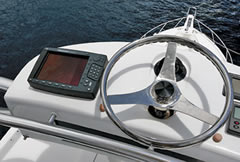March 13, 2012
By Al Herum
Network systems for maximum returns.

Keep a small, network screen high above in the tuna tower for more accurate work. |
Experienced anglers agree, when you're in the tower scanning the surface for busting tuna it is really a necessity to have your chartplotter and sounder right at your fingertips to hold the boat dead on the spot. Having a second, small network screen in the tower accomplishes that mission in high style with a full-featured graphical display.
Installing a multi-station network system is really no more complicated than installing several pieces of stand-alone electronics. It is usually a matter of cutting a hole in your electronics panel big enough for the display and then connecting all the wires. Adding a sounder involves mounting a black box in an out of the way location and connecting a few more wires. Of course, you'll still have to deal with the transducer install as you would with any type of sounder installation. Radar is a bit more difficult because of the large antenna and cable runs to the top of the bridge deck or tower. A big multi-component installation can be done in steps, adding functionality like radar, sounder, or additional display units as time and money permit.
Marine network systems follow a modular building block design where each piece of the system is self-contained in its own black box and connects to the rest of the system via cables. The multi-function display screen is the critical link. They are basically computer-based chartplotters with large screen displays that have the capability to display and operate all system functions including chartplotting, radar, sounder, video and weather. They are also equipped with a network cable connection that allows as many as five display screens to be interconnected.
All this functionality comes at a price though; the cost to equip your helm with a high-resolution, 6- to 8-inch color screen with chartplotting capability starts at around $1,800 and can run significantly higher depending on the manufacturer. Going with a bigger 10-inch display pushes the minimum price to nearly $3,000. The least you could spend to add a small second screen in the tower is about $1,000. Adding a 500- to 1,000-watt black box sounder to the system runs from $250 to nearly $800.
Black box radar options vary widely from one maker to the next with 2 kW dome antenna units priced from around $900 to about $1,500. Moving up to a 4 kW system runs between $1,500 and $2,500. If you use your radar to spot birds over dolphin and tuna it's best to go with higher power and an open array antenna. These units range in price from $3,000 to $6,000. Still, when you consider screen resolution and size, construction quality, sounder power and radar options you likely could not put together a comparable stand-alone system at these prices. Even if you could, you'd lose the functional versatility of a networked system.
If your boat is not already equipped with network-capable electronics and adding them is not in the plan right now, another lower cost alternative is still available. Most manufacturers of navigation and depth sounder gear also make repeaters that connect to their main units through a NEMA connection. Most are inexpensive and have monochrome digital display screens capable of listing a couple valuable pieces of data. Though a repeater lacks the extensive information display and interactive abilities of a full-featured network multi-function screen, they can still provide several pieces of valuable data to a remote location like the tower.
Depending on your unit's capabilities you may be able to display your position in lat/long and your current water depth at the same time. Surely not as nice as using a graphical map display to hold position, but just as accurate. Holding your boat over the spot this way is old school and the way most experienced charter captains have done things for years with both loran and GPS numbers. When used in combination with a compass and a little seamanship it is very easy to do.
FS
